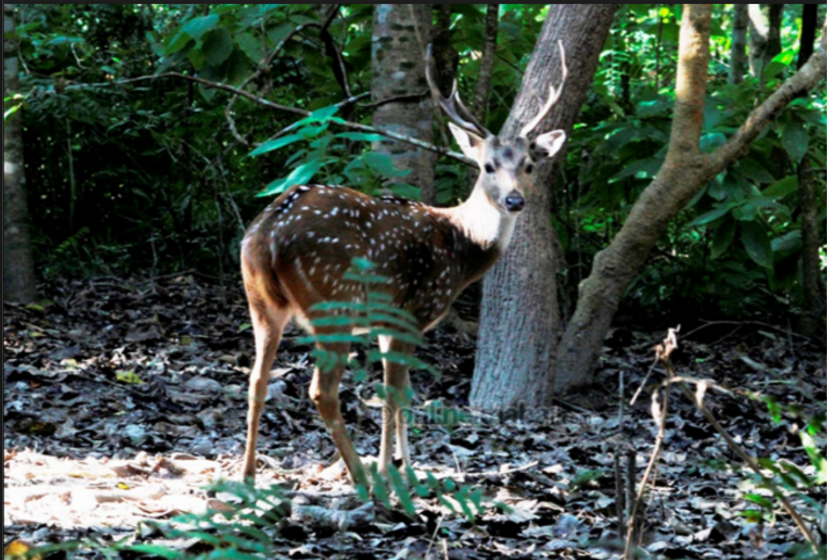Only a few decades ago, Kanchanpur was a malarial forest inhabited by the indigenous Tharus. But today, it has become heterogeneous. In 1871,the Tharus represented 43 percent of the total population; in 1991 the proportion, despite immigration, stood at only 27 percent. The Tharus are swamped by non-Tharu migrants from the hills. The hill tribes in the district composed of Brahman (15%), Chhetri (28%), Kami(10%), and Sarki (13%). Others include Thakuri, Sanyasy, Tamang, Magar and Damai. The overall literacy rate of Kanchanpur is 59.3 percent – female 45.2 percent in 1999, the latter being higher than the national average. However, 27 percent children between 6 to 10 years.
Kanchanpur District in the Mahakali Zone is Nepal’s most western district in the Tarai and shares its southern and western borders with India. Its population is one of the fastest growing in the country, mainly due to migration from the northern hills and partly due to the influx of the Tharus from adjoining districts in the east. In 1971, Kanchanpur had the population of 68,863; in 1991 it increased almost by four folds to 257,906 and in 2011 it increased to 451,248. The district is divided into 11 Ilakas (sub-districts), 19 VDCs and one municipality – Mahendra Nagar. Forest covers some 54 percent of its area including 311 sq. km under a Wildlife Reserve. Over 36 percent land is under cultivation and 20 percent of it is irrigated.
A stop at the Rani Tal (Rani Lake) is a must. This small lake attracts birds and animals alike. Herons, ducks, storks, kingfisher and egrets vie for food and swamp deer wallow at the edges. One can watch thousands of water fowl mingling on the lake surface while it is not uncommon to see hundreds of swamp deer grazing at the water-edge in the evening light. The experience is unique. Few tourists have visited the lesser-known trails of western Nepal, in spite of the presence of the Royal Bardiya Reserve. The Mahendra Highway, linking east and west, will inevitably encourage more visitors to the region.
The name of the park is derived from the largest of this grassland which is known as Sukla Phanta. The park area of 155 sq. km was originally the hunting grounds for the one-time Rana rulers of Nepal.Sukla Phanta’s grassland is one of the last remaining habitat for endangered animals such as hispid hare and the pygmy hog. Besides these, Sukla Phanta is the stronghold for another endangered animal, the Barasingha, or swamp deer. The grassy conditions seem to be ideal for the large deer and their number has been dramatically increased to more than 2,000 in recent times. Rana Tharu women in their traditional attire singing hori song Shuklaphanta Reserve This wildlife reserve is situated in the extreme southwest of Nepal, along the eastern bend of the Mahakali River. There are series of large and small grasslands fringed by forest made up primarily of sal.
Other wildlife of the park includes spotted deer, also seen in large numbers, hog deer, nilgai, wild dog, jackal, porcupine and otter. The park and the adjoining forest is the territory of small number of tigers which because of open terrain are not uncommon to sight on the prowl. Wild elephants were also sighted in park. According to local villagers, they are attracted by the rice crops during the monsoon season. Visitors should travel with tents, food and transport.Mahendranagar: Mahendranagar, about 270 meters about sea level, is a new settlement in the middle of a forest with the foothills visible to the north. The place was first cleared in 1962 when the district headquarters was shifted here from Belauri on the southern border. The main east-west street is lined up by a group of new houses made from plentiful timber. There are about two dozen shops. Apart from the hataru (marketer) from Dadeldhura, Doti and Baitadi, the place is already swarmed with squatters from the hills. The place has easy link with Tanakpur railhead, about an hour’s walk to the west. It is one of the major commercial place in the region. Moreover, as the zonal headquarters with 29 government offices, Mahendranagar claims primacy in managing the affairs of the entire Mahakali Zone that extends as far as 154 kilometers to the north.Dhami Pratha: The Dhami partha (Shamanism) is common in the region and decision he makes is acceptable to people as a word from god. Karnali, part of the Royal Bardiya Reserve, located on the eastern bank of the Karnali River, is a sanctuary for the endangered swamp deer. Tiger Tops runs Karnali Tent Camp, with accommodation for up to 16 guests. Shukla Phanta in Kanchanpur district, in the westernmost reaches of Nepal, is one of the few places in the country where the endangered blackbuck is found. Other ways to view wildlife in the park is by driving in land rovers near the lake and river, and on nature walks with trained trackers. Accommodation and outing are best prearranged through agents in Kathmandu. Access:There are daily/weekly air flights from Kathmandu to the nearby Dhangadhi airstrip. Bus service from Kathmandu and eastern part of Nepal is regular. The best time to visit is from November to April.
General Information Headquarters: Mahendranagar Literacy rate: 57.60% (Male, 70.53%; Female, 44.19%) Political constituencies: 4 Total no. of Municipalities: 1 (Mahendranagar – eighth-biggest city of Nepal) Area: 1610 km² Total Population:451,248 Political Boundary North: Daleldhura South: India East: Kailali and Doti West: India Major rivers Mahakali, Syauli, Chaughar, Wahamani, Chandar. Location Latitude: 280 32"-290 8" Longitude: 800 3"- 800 33"








0 comments:
Post a Comment